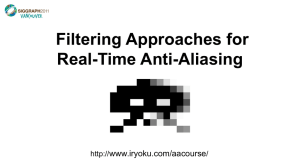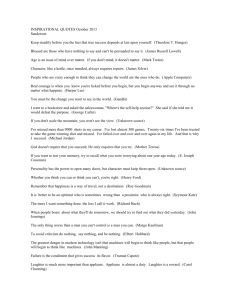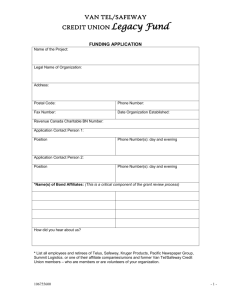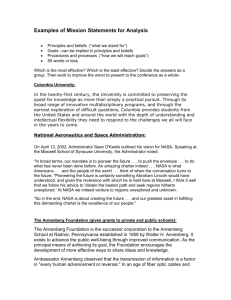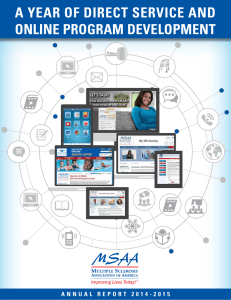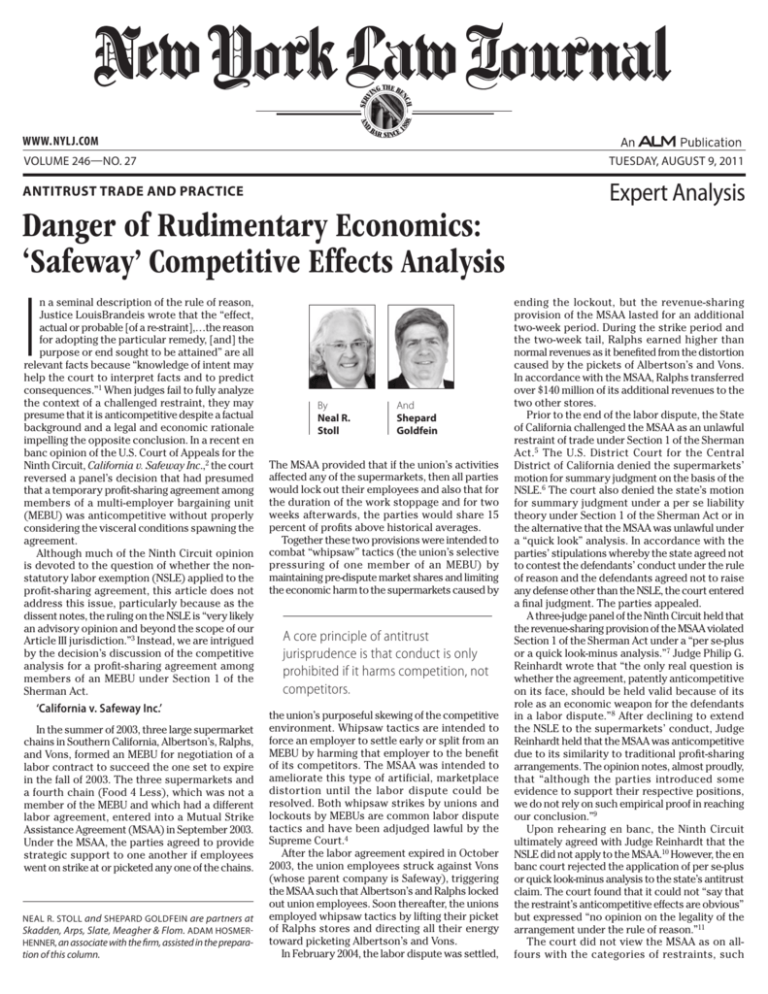
AND
88
8
SER
V
H
NC
THE BE
ING
1
BA
R SINCE
www. NYLJ.com
Volume 246—NO. 27
tuesday, august 9, 2011
Antitrust Trade and Practice
Expert Analysis
Danger of Rudimentary Economics:
‘Safeway’ Competitive Effects Analysis
I
n a seminal description of the rule of reason,
Justice LouisBrandeis wrote that the “effect,
actual or probable [of a re-straint],…the reason
for adopting the particular remedy, [and] the
purpose or end sought to be attained” are all
relevant facts because “knowledge of intent may
help the court to interpret facts and to predict
consequences.”1 When judges fail to fully analyze
the context of a challenged restraint, they may
presume that it is anticompetitive despite a factual
background and a legal and economic rationale
impelling the opposite conclusion. In a recent en
banc opinion of the U.S. Court of Appeals for the
Ninth Circuit, California v. Safeway Inc.,2 the court
reversed a panel’s decision that had presumed
that a temporary profit-sharing agreement among
members of a multi-employer bargaining unit
(MEBU) was anticompetitive without properly
considering the visceral conditions spawning the
agreement.
Although much of the Ninth Circuit opinion
is devoted to the question of whether the nonstatutory labor exemption (NSLE) applied to the
profit-sharing agreement, this article does not
address this issue, particularly because as the
dissent notes, the ruling on the NSLE is “very likely
an advisory opinion and beyond the scope of our
Article III jurisdiction.”3 Instead, we are intrigued
by the decision’s discussion of the competitive
analysis for a profit-sharing agreement among
members of an MEBU under Section 1 of the
Sherman Act.
‘California v. Safeway Inc.’
In the summer of 2003, three large supermarket
chains in Southern California, Albertson’s, Ralphs,
and Vons, formed an MEBU for negotiation of a
labor contract to succeed the one set to expire
in the fall of 2003. The three supermarkets and
a fourth chain (Food 4 Less), which was not a
member of the MEBU and which had a different
labor agreement, entered into a Mutual Strike
Assistance Agreement (MSAA) in September 2003.
Under the MSAA, the parties agreed to provide
strategic support to one another if employees
went on strike at or picketed any one of the chains.
Neal R. Stoll and Shepard Goldfein are partners at
Skadden, Arps, Slate, Meagher & Flom. Adam HosmerHenner, an associate with the firm, assisted in the preparation of this column.
By
Neal R.
Stoll
And
Shepard
Goldfein
The MSAA provided that if the union’s activities
affected any of the supermarkets, then all parties
would lock out their employees and also that for
the duration of the work stoppage and for two
weeks afterwards, the parties would share 15
percent of profits above historical averages.
Together these two provisions were intended to
combat “whipsaw” tactics (the union’s selective
pressuring of one member of an MEBU) by
maintaining pre-dispute market shares and limiting
the economic harm to the supermarkets caused by
A core principle of antitrust
jurisprudence is that conduct is only
prohibited if it harms competition, not
competitors.
the union’s purposeful skewing of the competitive
environment. Whipsaw tactics are intended to
force an employer to settle early or split from an
MEBU by harming that employer to the benefit
of its competitors. The MSAA was intended to
ameliorate this type of artificial, marketplace
distortion until the labor dispute could be
resolved. Both whipsaw strikes by unions and
lockouts by MEBUs are common labor dispute
tactics and have been adjudged lawful by the
Supreme Court.4
After the labor agreement expired in October
2003, the union employees struck against Vons
(whose parent company is Safeway), triggering
the MSAA such that Albertson’s and Ralphs locked
out union employees. Soon thereafter, the unions
employed whipsaw tactics by lifting their picket
of Ralphs stores and directing all their energy
toward picketing Albertson’s and Vons.
In February 2004, the labor dispute was settled,
ending the lockout, but the revenue-sharing
provision of the MSAA lasted for an additional
two-week period. During the strike period and
the two-week tail, Ralphs earned higher than
normal revenues as it benefited from the distortion
caused by the pickets of Albertson’s and Vons.
In accordance with the MSAA, Ralphs transferred
over $140 million of its additional revenues to the
two other stores.
Prior to the end of the labor dispute, the State
of California challenged the MSAA as an unlawful
restraint of trade under Section 1 of the Sherman
Act.5 The U.S. District Court for the Central
District of California denied the supermarkets’
motion for summary judgment on the basis of the
NSLE.6 The court also denied the state’s motion
for summary judgment under a per se liability
theory under Section 1 of the Sherman Act or in
the alternative that the MSAA was unlawful under
a “quick look” analysis. In accordance with the
parties’ stipulations whereby the state agreed not
to contest the defendants’ conduct under the rule
of reason and the defendants agreed not to raise
any defense other than the NSLE, the court entered
a final judgment. The parties appealed.
A three-judge panel of the Ninth Circuit held that
the revenue-sharing provision of the MSAA violated
Section 1 of the Sherman Act under a “per se-plus
or a quick look-minus analysis.”7 Judge Philip G.
Reinhardt wrote that “the only real question is
whether the agreement, patently anticompetitive
on its face, should be held valid because of its
role as an economic weapon for the defendants
in a labor dispute.”8 After declining to extend
the NSLE to the supermarkets’ conduct, Judge
Reinhardt held that the MSAA was anticompetitive
due to its similarity to traditional profit-sharing
arrangements. The opinion notes, almost proudly,
that “although the parties introduced some
evidence to support their respective positions,
we do not rely on such empirical proof in reaching
our conclusion.”9
Upon rehearing en banc, the Ninth Circuit
ultimately agreed with Judge Reinhardt that the
NSLE did not apply to the MSAA.10 However, the en
banc court rejected the application of per se-plus
or quick look-minus analysis to the state’s antitrust
claim. The court found that it could not “say that
the restraint’s anticompetitive effects are obvious”
but expressed “no opinion on the legality of the
arrangement under the rule of reason.”11
The court did not view the MSAA as on allfours with the categories of restraints, such
tuesday, august 9, 2011
as traditional profit-sharing arrangements,
that could be condemned without inquiry into
actual competitive harms. Instead, the court
considered that the MSAA was signed during the
special context of an impending labor dispute
and had distinguishing features such as “its
limited, indefinite duration and the presence of
other competitive firms in the market.”12 These
factors strongly suggested that the agreement
may not be anticompetitive at all and certainly
should not be condemned without a full rule of
reason analysis.
Actual Harm to Competition
A core principle of antitrust jurisprudence
is that conduct is only prohibited if it harms
competition, not competitors.13 This principle has
been continuously reaffirmed and cited to bar
unwarranted lawsuits against conduct that does
not reduce consumer welfare. Judge Reinhardt
dissented from the en banc decision, arguing that
even a “rudimentary knowledge of economics”
dictates that “the existence of the profit sharing
agreement results in a greater likelihood of reduced
competition.”14 His understanding of both law and
economics is far too rudimentary.
At the outset, Judge Reinhardt believed that the
MSAA was anticompetitive because it resembled
other unlawful profit-sharing arrangements. Rather
than looking at the similarities of appearance, the
judge should have looked at the similarities of
effects. Profit-sharing can reduce the incentives
to compete, leading competitors to increase the
price of goods or reduce output through means
such as halting discounting or advertising. There is
no indication, in fact or in theory, that price would
increase or output decrease during the MSAA.
A temporary revenue-sharing agreement to
cushion against labor externalities is unlikely
to result in any harm to competition for several
reasons. First, the MSAA is more accurately
analogized to a strike-insurance scheme than to
a profit-sharing arrangement. The parties were
neither attempting to function as a cartel pushing
prices to a monopoly level nor were they attempting
to use the context of a labor dispute as cover for
an anticompetitive agreement to reduce the output
or quality of goods or services. Instead, the MSAA
provided that in the event of a work stoppage,
an uncontrollable action by a third party, the
supermarkets could draw on an insurance fund
consisting of the higher profits that accrued to the
party unaffected by labor strife. This arrangement
does not harm competition any more than a flood
insurance program among farmers would reduce
their incentive to behave according to the inherent
supply and demand conditions they face.
Second, the MSAA’s limited duration is critical
to the competitive analysis and was summarily and
erroneously disregarded by Judge Reinhardt. The
revenue-sharing arrangement lasted only for the
duration of the work stoppage plus a two-week tail.
Concluding that the temporary revenue-sharing
would “at least to some degree reduce defendants’
incentive to compete,” Judge Reinhardt stated
that at best the anticompetitive effects would
be diminished but not eliminated. The temporal
limitation, however, is critical to the entire inquiry
as it discourages the parties from functioning as
a cartel.
The precedent relied upon by Judge Reinhardt,
addressed situations where the competitors
were functioning as a long-term single-entity for
economic reasons. For example, in Chicago, M. &
St. P. Ry. Co., the railroads entered into a 25-year
profit-sharing agreement by which railroads that
carried a low volume of freight were compensated
by the other railroads.15 The railroads, for an
extended period of time, had a reduced incentive
to compete for volume as they would receive
compensation for underperformance. Conversely,
where the agreement is of shorter duration, the
parties have a continuous incentive to compete
for customers or risk significant economic
harm at the conclusion of the revenue-sharing
understanding.
Judge Reinhardt dismissed defendants’ argument
that “customers might buy goods at some indefinite
point in the future in which profits would not be
shared” because “[a]ny such future incentives
are at best speculative and must be heavily
discounted.”16 However, the future benefits of
vigorous competition during the work stoppage
period were not speculative.
At the outset, Judge Reinhardt believed
that the MSAA was anticompetitive
because it resembled other unlawful
profit-sharing arrangements. Rather
than looking at the similarities of
appearance, the judge should have
looked at the similarities of effects.
In reversing, the en banc court not only doubted
whether the MSAA was anticompetitive, it implied
that the opposite conclusion may be warranted:
that MEBU labor tactics without a clear impact
on price or output may be presumptively lawful.
California may have recognized this as well by
stipulating to the dismissal of its claims if the
courts held that the conduct should be analyzed
under the rule of reason. Certainly though it is not
wise to assert, with only a rudimentary knowledge
of economics, that a concerted agreement by
competitors utilized as a tactic to correct a shortrun, skewed market outcome is per se harmful to
competition under the Sherman Act.
•••••••••••••
••••••••••••••••
1. Board of Trade of Chicago v. United States, 246 U.S. 231,
238 (1918).
2. California ex rel. Harris v. Safeway Inc., 2011 WL 2684942
(9th Cir. July 12, 2011).
3. Id. at *17 (Kozinski, J., dissenting).
4. NLRB v. Truck Drivers Local Union No. 449, 353 U.S. 87
(1957)
5. 15 U.S.C. §1.
6. California v. Safeway Inc., 371 F.Supp.2d 1179 (C.D. Cal.
2005).
7. California ex rel. Brown v. Safeway Inc., 615 F.3d 1171,
1180 (9th Cir. 2010).
8. Id. at 1177.
9. Id. at 1184.
10. California ex rel. Harris v. Safeway Inc., 2011 WL 2684942,
*1 (9th Cir. July 12, 2011).
11. Id. at *16 (internal quotations omitted).
12. Id. at *15.
13. Brunswick Corp. v. Pueblo Bowl-O-Mat Inc., 429 U.S. 477,
488 (1977).
14. Safeway Inc., 2011 WL 2684942 at *31 (Reinhardt, J.,
dissenting).
15. 61 F. 993 (8th Cir. 1894).
16. California ex rel. Harris v. Safeway Inc., 2011 WL at *30.
17. California ex rel. Brown v. Safeway Inc., 615 F.3d at
1175.
During the four months of the lockout, the
supermarkets would not have any incentive to
stop accepting coupons, discounting, or providing
quality service to their customers. Any supermarket
that reduced its competitiveness would find itself
with fewer customers and less brand loyalty at the
end of the work stoppage. Indeed, the picketed
supermarkets may have lowered their prices in order
to maintain volume. The MSAA does not provide any
incentive for a rational competitor to reduce output,
customer service, or raise prices because the parties
do not have a mutual economic interest other than
temporary protection from adverse labor distortions.
Accordingly, it may well be that the MSAA had no
anticompetitive effects upon consumers.
Conclusion
Judge Reinhardt stated in the panel opinion that
“we doubt that anyone would seriously suggest that
the agreement was lawful if it had been adopted
simply in order to benefit defendants economically,
and there had been no impending labor dispute.”17
Ignoring the labor issue to get to the antitrust
analysis, Judge Reinhardt failed to heed Justice
Brandeis’ instruction about the value of knowledge
of intent and effects. The important point is that the
MSAA was not adopted simply to benefit defendants
economically but to protect against whipsaw labor
tactics. And further, it is highly unlikely that the
MSAA had any anticompetitive effects on customers
because Albertson’s and Vons had every incentive
to price their products during the lockout in order
to motivate customers to cross picket lines.
Reprinted with permission from the August 9, 2011 edition of the NEW YORK LAW
JOURNAL © 2011 ALM Media Properties, LLC. All rights reserved. Further duplication
without permission is prohibited. For information, contact 877-257-3382 or reprints@alm.
com. # 070-08-11-17

